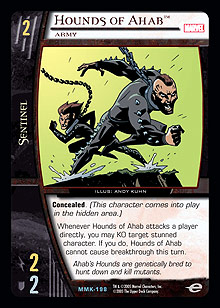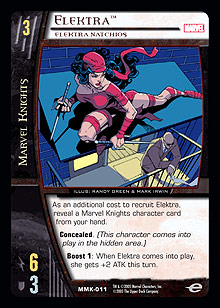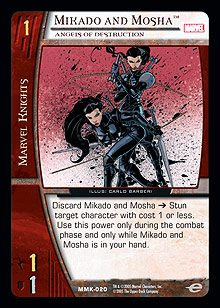
Welcome to the first installment of Team KG Archives. Over the next several weeks, I will talk about the Marvel Modern Age format and discuss the decks and strategies my teammates and I utilized to succeed at PC: Amsterdam. Our group earned $18,940 of the prize money in this tournament thanks extensive playtesting, and now that we are in the Modern Age PCQ season, I hope to pass on some of what we’ve learned to the Metagame.com readers.
Although I live in New York, I am a long-standing member of Boston-based team Your Move Games. YMG is perhaps the oldest existing team in competitive TCG play, with combined lifetime cash winnings of over $600,000. Many of its members, including Rob Dougherty, Danny Mandel, Darwin Kastle, Dave Humpherys, Zvi Mowshowitz, and myself were involved in the original development of Vs. System, and several—Mandel, Humpherys, and Justin Gary—now work for Upper Deck Entertainment full time.
I own Kings Games, a store in New York where Vs. System is very popular and there are a number of talented players who are qualified for the Pro Circuit. The two groups began collaborating for the first Pro Circuit, where Kings Games’s Felix Dykhne came up with the innovative Rigged Elections deck concept. Both groups fine-tuned the deck, and it eventually earned Craig Edwards a second place finish in that tournament.
For PC: Amsterdam, the Kings Games roster consisted of Daniel Chulsky, Rick Corredor, Dustin Pidgeon, and myself. Your Move Games would be represented by Rob Dougherty, Darwin Kastle, Craig Edwards, Anthony Shaheen, Jacob Rabinowitz, Chris Senhouse, and Nick Cuenca.
We tested a lot of decks and once again placed one of our numbers in the Top 8 with what one of the most consistent decks of the tournament. Six of the seven YMG players played a variant of Marvel Knights-Underworld designed by Darwin Kastle, while the Kings Games crew played the Dan Chulsky-inspired Marvel Knights–Sentinels–Crime Lords build we referred to in playtesting as “MK Hounds.”
All four of us made it into Day 2 playing this deck, with records of 9-3, 8-4, 8-4 and 7-5. Our decklist was as follows:
MK Hounds
Team Kings Games, PC: Amsterdam 2005
Characters
 4 Dagger, Child of Light
4 Dagger, Child of Light
1 Mikado and Mosha
7 Hounds of Ahab
1 Iron Fist, Danny Rand
4 Elektra, Elektra Natchios
2 Death-Stalker
4 Luke Cage, Street Enforcer
2 Moon Knight
4 Daredevil, Matt Murdock
1 Firestar
2 Elektra, Agent of the Hand
Plot Twists
2 Midnight Sons
4 Wild Ride
4 Crime and Punishment
4 Crushing Blow
4 No Fear
4 Head Shot
4 Quick Kill
Locations
2 Psychoville
The deck takes advantage of arguably the most powerful engine in the format—Dagger/Midnight Sons/Wild Ride—which gives the deck curve consistency that is far above average. You will rarely miss a drop playing a deck that revolves around this engine. The other powerful concept that sets this deck apart from many others is its ability to KO your opponent’s largest characters, giving you tremendous board advantage.
Almost every character you play in this deck is hidden. The downside of this is that your opponent can attack you directly on his or her initiative, dealing damage that will accumulate very quickly. As a tradeoff, your characters are ready to attack back every time, whether it is your initiative or not, and you have many ways to KO the largest opposing drops. When you do, your opponents will quickly fall behind in the damage race.
You will notice a lack of high drops in this deck. You basically never go to turn 7. You end the game by turn 6, and often on turn 5. If you go to turn 6, your preferred play is to boost an Elektra, making her a 17 ATK/9 DEF that cannot be stunned—better than any 6-drop your opponents might recruit.
Optimally, your game is going to proceed as follows:
Turn 1: Recruit Dagger or pass. You may sneak in a few points of damage with Dagger, but any time it looks like more than one of your characters is going to be stunned, you should return Dagger to your hand. While it is often correct to discard Dagger and search for Midnight Sons as early as possible, you should also remember that you need characters to discard to Quick Kill, so sometimes you are better served by holding onto Dagger.
Turn 2: Recruit Hounds of Ahab. On a perfect draw, you might stun a 2-drop with No Fear and then KO it with the Hounds. The potential for this play is one of the reasons you should always try to get the even initiative when playing this deck. Hounds are absolutely ridiculous and will sometimes win the game on their own, as your biggest drop continuously stuns the biggest opposing drop, and then you KO it with the Hounds. You can even draw some cards with Luke Cage when you activate Hounds or Quick Kill. Although there are seven Hounds in the deck and you should mulligan to find one, you will sometimes fail to draw it. When you do, you can implement the contingency plan of using Wild Ride to search out Iron Fist. It is not as good as recruiting a Hound, but infinitely better than flat-out missing your drop.
 Turn 3: Recruit Elektra, Elektra Natchios. If you did not draw Elektra, Death-Stalker is an alternate drop for this turn. You almost never want to use Death-Stalker’s ability, but its stats are as good as it gets for a hidden 3-drop that isn’t Elektra.
Turn 3: Recruit Elektra, Elektra Natchios. If you did not draw Elektra, Death-Stalker is an alternate drop for this turn. You almost never want to use Death-Stalker’s ability, but its stats are as good as it gets for a hidden 3-drop that isn’t Elektra.
Turn 4: Recruit Luke Cage. He’s almost always better than Moon Knight, though in some matchups (and only if you have initiative on this turn), you might choose to recruit Moon Knight. This only happens about ten percent of the time. In fact, you may often choose to Wild Ride for Luke Cage even if you have Moon Knight in hand—Luke is that important. In a mirror match, you almost always want to use Luke Cage and Psychoville to get ahead on life points.
Turn 5: Recruit Daredevil, The Man With Fear. He is so scared that he does not ever want to be a defender. He jumps out of the way into the hidden area, saying, “See you in a minute when it’s my turn to attack!” If you are facing an off-curve deck such as Wild Pack, Witching Hour, or sometimes even Honor Among Thieves, you might choose to recruit Firestar. She annihilates low-drop decks with her built-in Flame Trap ability. However, you won’t find yourself recruiting her very often. If you think that turn 5 is likely to be the last turn of the game, a better play is to recruit Elektra, Agent of the Hand—just don’t forget to team up Crime Lords first.
Turn 6: Recruit Elektra with boost or Moon Knight with boost. Elektra is clearly the better play here.
Besides Wild Ride, most of your plot twists are combat modifiers. You have enough tricks to make sure that you can always stun your opponent’s guys. Quick Kill will help you get on the Hound plan when your opponent is able to match you drop for drop. One of your most potent combat modifiers is Crushing Blow. It is best on turns when your opponent has the initiative. He or she is unlikely to choose not to attack you at all—and if that does happen, you’ll be in an even better shape than if you had used Crushing Blow. Each time you attack, you should try to find ways to not lose a character so that your forces continue to build up. Crushing Blow really helps out this strategy.
While Head Shot gets better later in the game, be mindful that an experienced opponent will try to set up on turns 5 and 6 in such a way that he or she is able to reinforce against your first attack—don’t hesitate to use your Head Shots on turn 4 if it will put your opponent within range of losing on the following turn.
There are a few useful tricks to remember in order to take full advantage of your cards:
 You can always pay 1 with Wild Ride to get Mikado and Mosha and stun a 1-drop. This is especially important against decks like Syndicate and Wild Pack. The current metagame may actually call for a second Mikado and Mosha to be added to the deck.
You can always pay 1 with Wild Ride to get Mikado and Mosha and stun a 1-drop. This is especially important against decks like Syndicate and Wild Pack. The current metagame may actually call for a second Mikado and Mosha to be added to the deck.
If you fail to set up the Hound engine, save Quick Kill for their 4-drop, unless you draw multiple Quick Kills, in which case you want to take their 3- and 4-drops. However, you may choose to use it earlier if you think it will allow you to start activating the Hounds.
Psychoville’s main function is in the mirror match, where you want to bring your opponent’s characters into the light and attack them. However, do not neglect its other abilities. You can add a point of DEF to your characters (even on attack) to prevent them from stunning. You can also surprise your opponent by moving one of your own characters into the visible area and using it to reinforce a Moon Knight or a character that was moved out by your opponent’s Psychoville.
On to the matchups:
You are really happy to face any other Marvel Knights-based deck. Be it Spider-Friends, Crime Lords, or Underworld, all those builds are going to have various degrees of difficulty against you, and you are a favorite in every one of these matchups. Off-curve matchups, such as Wild Pack, are also good. It is virtually impossible to lose to Witching Hour. On the other hand, the X-Statix deck is a terrible matchup, and Adam Horvath’s winning Crime Lords/Syndicate deck is a bad matchup as well.
Hounds was an excellent choice for the Pro Circuit, but it will become more of a metagame call in the PCQ season following it. If X-Statix are prevalent in your area, you probably do not want to play this deck. If not, it stands a very solid chance of winning a PCQ. The only changes I would make based on what we learned in Amsterdam would be to replace one Firestar and one Daredevil with a second Mikado and Mosha and a third Death-Stalker. Both should somewhat improve your matchup against the Syndicate.
Next week I am going to cover the Marvel Knights/Underworld build played by Your Move Games, as well as our playtest version of Marvel Knights/Spider-Friends. If you have any questions or comments about the Hounds deck and this article, please feel free to email me at ashv (at) kingsgames (dot) com.